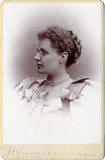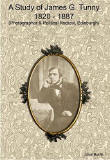|
James Good Tunny
1876 Studio
|
|
In 1876, James Good Tunny's studio was
at 13 Maitland Street (now re-named Shandwick Place), Edinburgh.
John Nicol, in his 'Notes from the
North' published in the British Journal of Photography gave a very
comprehensive account of this studio in 1876.
|
|
B J P
Notes from the North
|
|
This account appeared
in
Nicol's Notes from the North
column in the British Journal of Photography:
|
Tunny's Studio
"... It is pretty well known that
in point of time Mr Tunny is one of the oldest, if not the oldest
professional photographer in Scotland, and therefore, in consequence of
the large experience which he has thereby gained, the erection of a new
studio with all the usual working appliances, in a situation where he
could carry out his own ideas without let or hindrance, has been watched
with considerable interest.
In addition to his long
experience as a practical photographer, Mr Tunny recently spent six months
in the
United States, where he visited most of the principal studios
thee, so that the establishment just completed may be regarded as the
outcome both of much experience and of extensive observation." |
|
|
"In the early days of photography
Mr Tunny carried on successfully for many years a business in the
southern suburbs of Edinburgh.
As photography became popular,
and the competition increased, he considered it desirable to migrate to
the centre and fitted up an extensive establishment in
Princes-street, which was also carried on with considerable success.
Some years ago, in consequence of
a desire for the purer air and greater quiet of the suburban residence,
together with additional space for the execution of larger work, he
returned to the southern side where he erected an extensive and convenient
studio, and a series of very complete work-rooms." |
|
|
"These were a few years ago burnt
down, but only to be re-erected on a more extensive and perfect scale.
During this time, the studio in Princes Street was carried on as a branch
establishment, but in consequence of the property having been acquired by
an insurance office, he found it necessary to look out for another
position, and under the impression that, as is generally the case, the
money-possessing and money-spinning portion of the inhabitants were moving
in a westerly direction, he decided to follow them in the hope of coming
in for a share of their surplus wealth.
With this object in view, shortly
after his return from America, Mr Tunny purchased a large house in
Shandwick Place, and having razed it to the ground, commenced the present
edifice which has been so successfully completed .
The building is four stories in
height and projects a few feet farther into the street than those to the
east and west of it. Externally, it has an imposing effect, the
architecture being in the Italian style, the front consisting principally
of glass, and so arranged that fine views of the street, both east and
west are obtained form the principal windows." |
|
|
John Nicol went on to describe the
rooms in Tunny's premises. These included the following, each described in
detail by Nicol:
|
Basement |
storage rooms, furnace and
boiler. |
|
Lobby |
25 x 12 feet, handsomely
decorated with ornamental glass doors. The walls are hung with
fine specimens of enlargements in various styles, including
paintings in oil. |
|
Exhibition Room |
30 x 15 feet, elegantly
furnished, intended to be exclusively used for exhibiting
photographs in oil. |
|
Retouching/Spotting Room |
24 x 15 feet, fitted with
numerous desks for spotting, and a table for cutting and mounting, with
rolling press and burnishers. |
|
Painting Room |
Small but luxuriously finished,
lit from two sides and from the roof. |
|
Printing Department |
30 x 20 feet, along one length of
the room is a table on which printing frames are laid, covered with a
series of sashes glazed with ground glass and placed at an angle, so
that the work may be carried on during rain as well as in sunshine. |
|
Fixing, Toning and Washing Room |
This room included a depositing
sink in which most of the silver used was recovered. |
|
Gallery |
28 x 22 feet, magnificently
furnished, ornamented in the highest style of art, and containing
large quantities of the very best of Mr Tunny's work in monochrome.
- with couches and chairs covered
in crimson Utrecht velvet, fine Indian curtains and an organ. |
|
Studio |
28 x 21 feet x 18 feet high. |
|
Darkroom |
14 x 14 feet, lit by a large
window with orange glass. |
|
Enlarging Room |
14 x 14 feet fitted up with the
most convenient and perfect apparatus. |
[BJP: 25
February 1876; p90] |
|


